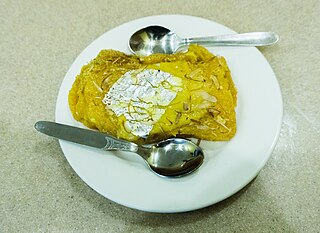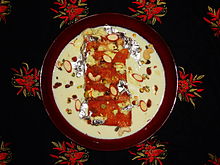
Pudding is a type of food. It can be either a dessert or a savoury dish served as part of the main meal.

Cornbread is a quick bread made with cornmeal, associated with the cuisine of the Southern United States, with origins in Native American cuisine. It is an example of batter bread. Dumplings and pancakes made with finely ground cornmeal are staple foods of the Hopi people in Arizona. The Hidatsa people of the Upper Midwest call baked cornbread naktsi. Cherokee and Seneca tribes enrich the basic batter, adding chestnuts, sunflower seeds, apples, or berries, and sometimes combine it with beans or potatoes. Modern versions of cornbread are usually leavened by baking powder.

Punjabi cuisine is a culinary style originating in the Punjab, a region in the northern part of South Asia, which is now divided in an Indian part to the east and a Pakistani part to the west. This cuisine has a rich tradition of many distinct and local ways of cooking.

Biryani is a mixed rice dish originating among the Muslims of South Asia. It is made with Indian spices, vegetables, rice, and usually some type of meat, or in some cases without any meat, and sometimes, in addition, eggs and potatoes.

Haleem is a type of stew that is widely consumed in South Asia, the Middle East and Central Asia. Although the dish varies from region to region, it optionally includes wheat or barley, meat and lentils. It is made by blending or mashing the meat in the curry and serving hot with flat breads or on its own. The original Haleem, which is different from this variety, is an ancient Iranian dish served with wheat, meat, cinnamon, and sugar that remains popular in Iran to this day. Popular variations of haleem include keşkek in Turkey, Afghanistan, Tajikistan, Uzbekistan, Azerbaijan and northern Iraq; harisa in the Arab world and Armenia; halim in Iran, West Bengal, in Mauritius and Bangladesh; and khichra in Pakistan and India.

Jalebi is a popular sweet snack in South Asia, Middle East, Africa, and Mauritius. It goes by many names, including jilapi, zelepi, jilebi, jilipi, zulbia, jerry, mushabak, z’labia, zengoula or zalabia.

Rajasthani cuisine is the cuisine of the Rajasthan region in North West India. It was influenced by various factors like the warlike lifestyles of its inhabitants, the availability of ingredients in an arid region and by Hindu temple traditions of sampradayas like Pushtimarg and Ramanandi. Food that could last for several days and could be eaten without heating was preferred. Scarcity of water and fresh green vegetables have all had their effect on the cooking. Signature Rajasthani dishes include Dal Baati Churma, Panchratna Dal, Papad ro Saag, Ker Sangri, Gatte ro Saag. It is also known for its snacks like Bikaneri bhujia, Mirchi bada and Kanda kachauri. Other famous dishes include Dal Baati, malaidar special lassi (lassi) and Lashun ki chutney, Mawa lassi from Jodhpur, Alwar ka mawa, Malpauas from Pushkar and rasgulla from Bikaner, "paniya"and "gheriya" from Mewar. Originating for the Marwar region of the state is the concept Marwari Bhojnalaya, or vegetarian restaurants, today found in many parts of India, which offer vegetarian food of the Marwari people. The history also has its effect on the diet as the Rajputs preferred majorly a non-vegetarian diet while the Brahmin, Jains, and others preferred a vegetarian diet. So, the state has a myriad of both types of delicacies.

Hyderabadi biryani is a style of biryani originating from Hyderabad, India made with basmati rice and meat. Originating in the kitchens of the Nizam of Hyderabad, it combines elements of Hyderabadi and Mughlai cuisines. Hyderabad biryani is a key dish in Hyderabadi cuisine and it is so famous that the dish is considered synonymous with the city of Hyderabad.

Cuisine of the Indian subcontinent includes the cuisines from the Indian subcontinent comprising the traditional cuisines from Bangladesh, Bhutan, India, the Maldives, Nepal, Pakistan and Sri Lanka.
Mithai (sweets) are the confectionery and desserts of the Indian subcontinent. Thousands of dedicated shops in India, Bangladesh, Nepal, Pakistan and Sri Lanka sell nothing but sweets.

Hyderabadi Muslims, also referred to as Hyderabadis are a community of Deccani people, who are part of a larger ethnic group of Urdu-speaking Muslims, from the area that used to be the princely state of Hyderabad in the regions of Marathwada, Telangana, and Kalyana-Karnataka.

Khubani ka meetha or qubani ka meetha is a Hyderabadi dessert made from dried apricots. It is a part of Hyderabadi cuisine and is a common feature at Hyderabadi weddings.

Hyderabadi cuisine, also known as Deccani cuisine, is the native cooking style of the Hyderabad, Telangana, India. The haute cuisine of Hyderabad began to develop after the foundation of the Bahmani Sultanate, and the Qutb Shahi dynasty centered in the city of Hyderabad promoted the native cuisine along with their own. Hyderabadi cuisine had become a princely legacy of the Nizams of Hyderabad as it began to further develop under their patronage.

Mughlai cuisine consists of dishes developed or popularised in the medieval Indo-Persian cultural centres of the Mughal Empire. It represents a combination of cuisine of the Indian subcontinent with the cooking styles and recipes of Central Asian and Islamic cuisine. Mughlai cuisine is strongly influenced by the Turkic cuisine of Central Asia, the region where the early Mughal emperors originally hailed from, and it has in turn also influenced the regional cuisines of Northern India, Pakistan and Bangladesh to little extent.
Bihari cuisine is eaten mainly in the eastern Indian state of Bihar, as well as in the places where people originating from the state of Bihar have settled: Jharkhand, Eastern Uttar Pradesh, Bangladesh, Nepal, Mauritius, South Africa, Fiji, some cities of Pakistan, Guyana, Trinidad and Tobago, Suriname, Jamaica, and the Caribbean. Bihari cuisine includes Bhojpuri cuisine, Maithil cuisine and Magahi cuisine.

The culture of Hyderabad, also known as Hyderabadi Tehzeeb or Dakhini Tehzeeb, is the traditional cultural lifestyle of the Telugu people and Hyderabadi Muslims, and characterizes distinct linguistic and cultural traditions of North and South India, which meet and mingle in the city and erstwhile kingdom. This blending was the result of the geographic location of the region and the variety of historical dynasties that ruled the city across different periods—its inception by the Qutub Shahi dynasty in 1591 AD, the occupation by the Mughal Empire and its decline, and the patronage under the Asaf Jahi dynasty.

Shahi Tukra is type of bread pudding which originated in South Asia during the Mughal era in the 1600s. The literal translation of Shahi Tukra is royal piece or bite. Shahi tukre originated in the Mughal Empire when Indian chefs made this dish to present to royal Mughal courts. The white bread is fried in oil/ghee after which milk and sugar is added. The dish is flavored using saffron, cloves, and cardamom.

















